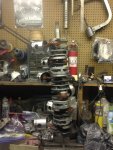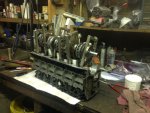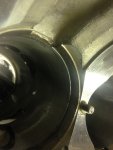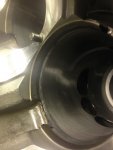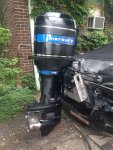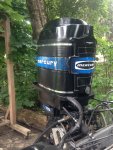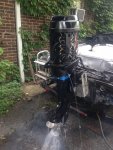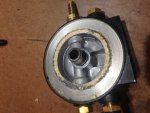mrmotts
Cadet
- Joined
- Dec 27, 2016
- Messages
- 10
Hi, I've been working on a 1979 1/2 (ADI ignition) tower 115hp for a few years and doing lots of reading on here. Replaced rotted stator, trigger, and switchboxes chasing down ignition issues, cleaned carbs, water pump, fuel pump, re-sealed trim cylinders, and added a voltage regulator and water pressure gauge. Finally got it running pretty good, then it just shut down while WOT on the last ride of the year... luckily it still ran, so I limped it back home and cyl #3 was shot, 0 psi, 128-124 on all others. Spark plugs all looked way too clean, especially #3. Figured I'd pull it apart, find the cause, and try to rebuild it since it's already got a fair amount of new hardware.
I pulled off the exhaust plates, and the lack of carbon along the lower portions of the inner plate seem to point to water intrusion. I figured maybe it was the lower seal, but when I rested the plates back on the block after cleaning, I could see they were extremely bowed in the center. The bolts were almost too easy to remove, some barely needed heat... perhaps this was the initial point of failure, causing the inner plate to high-center on the block, letting water in. I manged to sand the inner plate down pretty flat, but I have no clue how to mill the middle plate, so I scavenged one from a donor motor which looks pretty good after filling in some minor pitting with JB Weld. I plan to re-seal the assembly using locktite red and following Jeff Grigg's article on water leaks.
Now I'm ready to have the block mic'ed and bored by a shop. It seems to make sense to spend the $ and do all pistons oversize while it's all apart. Got both top & bottom bearings off the crank for replacement (holy crap the top one was a bear), and I tried to clean up the crank journals the best I could with fine sandpaper (600 to 1500 grit).
I can't seem to upload images so here's a link: http://imgur.com/a/fqcr3
I have some questions since this is my first time inside a block...
1. Does water intrusion seem like the culprit here? Carbs were very clean.
2. The needle cages look pretty bad, I'm guessing these should be replaced?
3. The most daunting task for me seems to be getting the cylinders back inside the block without the compressors. I plan to hang the crank from the ceiling and carefully lower it in one ring at a time... but is there an easier way? Can the crank be installed with the pistons already in the cylinders?
I pulled off the exhaust plates, and the lack of carbon along the lower portions of the inner plate seem to point to water intrusion. I figured maybe it was the lower seal, but when I rested the plates back on the block after cleaning, I could see they were extremely bowed in the center. The bolts were almost too easy to remove, some barely needed heat... perhaps this was the initial point of failure, causing the inner plate to high-center on the block, letting water in. I manged to sand the inner plate down pretty flat, but I have no clue how to mill the middle plate, so I scavenged one from a donor motor which looks pretty good after filling in some minor pitting with JB Weld. I plan to re-seal the assembly using locktite red and following Jeff Grigg's article on water leaks.
Now I'm ready to have the block mic'ed and bored by a shop. It seems to make sense to spend the $ and do all pistons oversize while it's all apart. Got both top & bottom bearings off the crank for replacement (holy crap the top one was a bear), and I tried to clean up the crank journals the best I could with fine sandpaper (600 to 1500 grit).
I can't seem to upload images so here's a link: http://imgur.com/a/fqcr3
I have some questions since this is my first time inside a block...
1. Does water intrusion seem like the culprit here? Carbs were very clean.
2. The needle cages look pretty bad, I'm guessing these should be replaced?
3. The most daunting task for me seems to be getting the cylinders back inside the block without the compressors. I plan to hang the crank from the ceiling and carefully lower it in one ring at a time... but is there an easier way? Can the crank be installed with the pistons already in the cylinders?




















